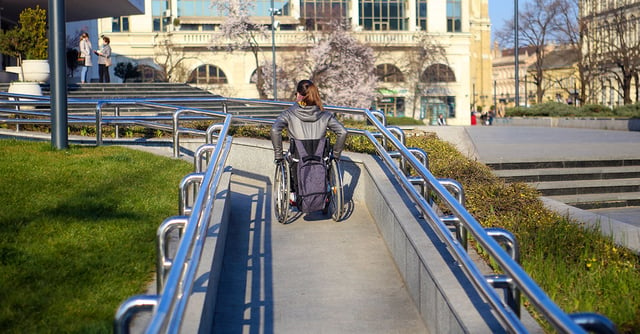
Mar 19, 2024Universal design – the key for inclusion and accessibility

Back to Blog Overview
In this blog, we take you on a deep dive into universal design so you can understand and recognize how these principles are implemented, can be used, and most importantly, how you can demand more accessible and inclusive solutions.
This article covers:
- What is universal design?
- Seven principles of universal design
- Application of universal design
- Benefits of universal design
- Challenges of universal design
- The future of universal design
What is universal design?
Universal design – also called inclusive design - is a principle and philosophy aimed at creating environments, products, and services accessible and usable by all people, regardless of their age, ability, or status. It is about accommodating the needs of people with disabilities but also about creating a world that is more accessible and comfortable for everyone.
This design principle acknowledges the diversity of human abilities and preferences, seeking viable and functional solutions for every member of society without the need for adaptation or specialised design.
In the UK, the Equality Act 2010 underscores the importance of universal design by requiring reasonable adjustments to prevent discrimination against people with disabilities. This legislation drives the implementation of universal design principles across various sectors, ensuring accessibility and inclusion are prioritised.
The seven principles of universal design
To implement universal design in practice, seven fundamental principles have been developed as guidelines for designers and developers:
- Equal opportunity for use: The cornerstone of universal design is that the design should be usable and accessible to people with a variety of abilities. This means that the design should be equally usable and accessible for a person with disabilities as for one without. For example, an entrance door with a low threshold and automatic opening service serves not only wheelchair users but also parents with pushchairs or people carrying heavy loads.
- Flexibility in use: The design should accommodate a wide range of individual preferences and abilities. This principle emphasises the need for flexibility in the design that can meet the needs and desires of various users. An example could be software that allows customisation of the user interface, such as text size or colour choice, to accommodate users with visual impairments or preferences for visual presentation.
- Simple and intuitive use: The design should be easy to understand and use, regardless of the user's experience, knowledge, language skills, or concentration level. This means that products and environments should be intuitive, so users can easily understand how to use them without extensive instructions. An intuitive design helps users navigate, understand, and utilize features effectively.
- Perceptible information: The design must convey necessary information in a way that is accessible to everyone, regardless of ambient conditions or the user's sensory abilities. This can include the use of different modalities (visual, tactile, and auditory) to ensure information is accessible. For example, a traffic light that displays visual signals and plays a sound ensures that information on when it is safe to cross the road is available to both visually and hearing-impaired individuals.
- Tolerance for error: The design should minimise risks and the adverse consequences of unintended or accidental actions. This principle focuses on reducing potential hazards and ensuring that errors do not result in significant problems. For example, a car that automatically provides a warning or adjusts its course if it detects potential collision helps prevent accidents even if the driver makes a mistake.
- Low physical effort: The design should be usable efficiently and comfortably, with minimal fatigue. This principle ensures that users can operate or interact with the design over extended periods without discomfort or fatigue. For instance, furniture like office chairs or keyboards should promote good ergonomics to reduce strain and enhance comfort.
- Size and space for access and use: The design must provide adequate size and space for access, reach, manipulation, and use, regardless of a person's body size, posture, or mobility. This ensures that all users, regardless of their physical characteristics, can use the product or service comfortably. For example, a public restroom should have enough space to accommodate wheelchair users, with handles and other aids to support accessibility.
Usage of universal design
Universal design is not limited to specific fields but is interdisciplinary and can be applied in various contexts, making it highly relevant and important. It applies in many dimensions, such as architecture, product development, digital media, and the education sector.
In the world of architecture, universal design plays a critical role in shaping the environments we live in. When buildings and public spaces are planned with universal design in mind, it ensures that these places are accessible to everyone, regardless of mobility or other physical abilities. This includes wider doorways for wheelchair users, ramps instead of stairs, tactile markings for the visually impaired, and hearing loops for those with hearing impairments. These adaptations make public spaces like parks, museums, libraries, and public transport more accessible and useful for a broader spectrum of the population.
In terms of product development, universal design has the power to revolutionise the way products are designed and used. By integrating universal design principles, product developers can create items that are more user-friendly for a broader range of people, including those with various physical or sensory abilities. This can range from household appliances with more intuitive controls to personal devices that are easier to use for individuals with motor challenges.
In digital media and technology, universal design has proven crucial in creating more inclusive digital experiences. This includes developing websites, software, and mobile applications that are accessible to everyone, including those with visual or hearing impairments, or those who require alternative navigation methods. Examples of this can include text-to-speech functionality, alternative text for images, and adaptable user interfaces that can be altered based on the user's needs.
In the education sector, universal design ensures that learning materials and environments are accessible and facilitate the success of all students, regardless of their individual learning needs. This can include everything from physical changes in the classroom to accommodate different learning styles and abilities, to the development of inclusive curricula and access to assistive technologies.
Benefits of universal design
The benefits of universal design extend far beyond those it immediately serves. Firstly, it increases accessibility and usability for a wide spectrum of users. Secondly, by preventing exclusion, it promotes social inclusion and equality. Economically, universal design can reduce the need for subsequent adaptations and expand the market reach for products and services.
Challenges of universal design
While the benefits of universal design are clear and numerous, the implementation of this important concept faces several challenges that can hinder its broader adoption and effectiveness. Understanding these obstacles is crucial for users, caregivers and society to promote a more inclusive approach to design and development across all sectors.
A primary challenge is the lack of awareness and understanding among key players such as policymakers, designers, and the public. Many people may not be fully informed about what universal and accessible design entails or its potential benefits for the whole community. This knowledge gap can lead to universal design being overlooked or underestimated in planning and design processes, resulting in solutions that are not optimally accessible for all users.
Additionally, the implementation of universal design encounters economic barriers. Initial investments in universal design can be significant, as it often requires a comprehensive assessment of users' needs, as well as the development and testing of solutions that accommodate a broad range of users. For many organisations, these startup costs may seem daunting, even though they can lead to long-term cost savings by reducing the need for subsequent modifications and increasing accessibility for a wider audience.
Another challenge is the need for interdisciplinary collaboration. Universal design often requires collaboration between designers, engineers, user experience experts, and end users, including people with disabilities. Establishing an effective communication and collaboration channel between these groups can be difficult but is crucial for creating solutions that are truly universally designed. Technological advancements also pose a challenge, as the constant shift in the technological landscape requires universal design to adapt quickly to remain relevant and effective. This means organisations must be committed to continuous learning and adaptation, which can require resources and a culture of innovation.
All actors are nevertheless obligated to adhere to the principles of universal design by the equality act, and for it to be feasible to comply with in practice, they need to adapt to these challenges and find ways to meet them.
The future of universal design
The future of universal design is truly promising, as awareness of its importance continues to grow and technological innovation continues to push the boundaries of what is possible. Artificial intelligence (AI) and machine learning are among the most exciting fields where technology has the potential to revolutionise universal design, offering sophisticated solutions that can adapt to and respond to users' individual needs in ways previously unimaginable.
For example, with AI, we can envision a future where digital interfaces can automatically adjust themselves to accommodate a user's specific visual, auditory, or motor needs, creating a more personalised and accessible user experience. Machine learning can also play a role in enhancing accessibility by learning from user interactions to continuously improve and optimise user interfaces.
In addition to technological advancements, there is a growing recognition of the value of accessibility and inclusion across different sectors. From public policy to private enterprise, there is an increasing understanding that universal design is not only the right thing to do but also has economic and social benefits. Businesses and organisations are beginning to realise that by embracing universal design, they can reach a broader audience, improve customer satisfaction and loyalty, and foster innovation.
The education sector is also seeing an increasing integration of universal design into curricula, preparing the next generation of designers, engineers, and policymakers to prioritsise inclusion in their work. This bodes well for the future, as it ensures a sustained growth in awareness and skills related to universal design.
Although there are challenges to overcome, such as the need for continuous education and overcoming economic barriers, the momentum is clearly positive. With commitment from all sectors of society, from governments to private companies and individual consumers, we can look forward to a future where universal design is the standard, not the exception. This will not only create a more inclusive world for people with disabilities but improve the user experience for everyone, demonstrating the power and potential of true universal design.
Sources:
https://www.legislation.gov.uk/ukpga/2010/15/contents
https://design-system.service.gov.uk/accessibility/accessibility-strategy/
https://www.ed.ac.uk/information-services/learning-technology/accessibility/universal-design
https://digital.nhs.uk/blog/design-matters/2023/what-is-inclusive-design
https://www.open.ac.uk/blogs/design/barriers-to-inclusive-design/
https://www.texthelp.com/resources/universal-design-for-learning/technology-and-udl/
https://www.digitallearninginstitute.com/blog/leveraging-ai-in-accessible-design#

Rikke Damkjær Moen brings many years of experience as clinical physiotherapist to the Made for Movement team. Her mission is to ensure that everybody, regardless of mobility problems, should be able to experience the joy and health benefits of physical activity. As our Medical Manager, Rikke is passionate about sharing knowledge so that individuals with special needs, families, and clinicians can discover the possibilities and solutions provided by Made for Movement.


